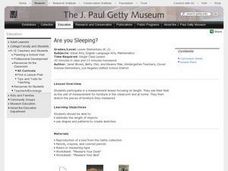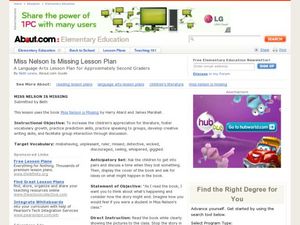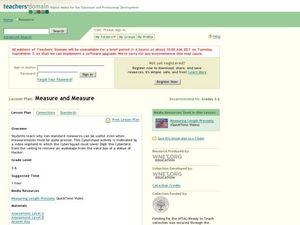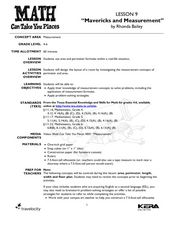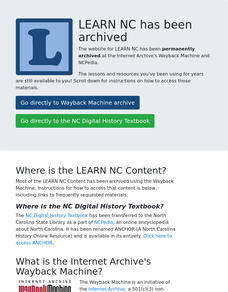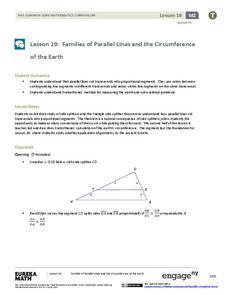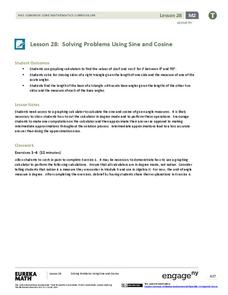Curated OER
Fish and Clips
Youngsters test magnetic strength by measuring the mass of paper clips that they "hook" with a magnet. Your first and second graders should love the hands-on activities associated with this plan. The reproducible materials are quite good...
Curated OER
Dilations in the Plane
Tenth graders investigate dilations and explore the dilation transformation before investigating the properties of a dilation using Cabri Jr. Young scholars extend the concept of dilatation to the coordinate plane.
Curated OER
Simple Measurements
Students determine the height of objects using shadows. In this math lesson, students discus methods of finding the height of items without directly measuring. Students measure shadows and figure the actual height of the object.
Curated OER
Patterns in the Sums of Polygon Angles
Sixth graders discover the patterns of sums of polygon angles. In this math lesson, 6th graders study the properties of geometric shapes to solve problems as they participate in hands-on activities.
Curated OER
Can You Measure Up?
Young scholars use technology to visit websites where they play interactive games, gather information to complete activity sheets, and complete online projects. One lesson using 'Inch By Inch' by Leo Lionni, takes students to an...
Curated OER
Measurement Crafts- Cereal Hands and Feet
Students identify nonstandard units of measurement and investigate area of objects. In this geometry instructional activity, students trace their hands and glue cereal pieces to the print to find the area.
Curated OER
Measurement: Lesson 3
Eighth graders investigate the concepts that are related to measurement while focusing upon weight, mass, and capacity. They estimate the weight and mass relationship that is found in different problems. Students compare and contrast one...
Curated OER
Lessons for Atlatl Users with Some Experience-Grade 5
Fifth graders throw darts, collecting data for distance traveled. In this data analysis instructional activity, 5th graders throw a dart using an atlatl. They calculate the speed for each throw and determine the best dart length for...
Curated OER
Measurement: Cylinders
Math scholars observe and demonstrate how to calculate the surface area and volume of cylinders. They analyze pictures of various cylinders on a handout, solve problems on two worksheets independently, and discuss the answers to the...
Curated OER
Are You Sleeping?
Here is a measurement lesson plan focusing on length. Learners use their feet as the unit of measurement for furniture in the classroom and at home, and sketch the pieces of furniture they measured.
Curated OER
Sports and Hobby Math
Explore math concepts as they relate to real world situations. Young analysts consider a personal hobby or favorite sport and list three ways math is involved in the hobby. They create several related math story problems and write a...
Curated OER
Miss Nelson is Missing Lesson Plan
Second graders listen to the story Miss Nelson is Missing by Harry Allard and James Marshall. In this literature activity, 2nd graders predict the story's ending with drawings and discussions within groups.
Curated OER
Measure and Measure
Learners use video integration to help them learn about non-standard measurements. In this measurements lesson, students watch a video about measurement. Learners determine which non-standard measurement unit would be best to solve the...
Curated OER
Mavericks and Measurement
Young scholars study the measurement formulas for area and perimeter in real-life situations. In this area and perimeter lesson, students design a bed and arrange furniture in a hotel room using area and perimeter formulas for a 7 1/2...
Curated OER
Measure Mania
Pupils measure their own silhouette using Unifix cubes. They measure a drawing using non-standard measurement. They swap drawings and compare their measurements.
EngageNY
Families of Parallel Lines and the Circumference of the Earth
How do you fit a tape measure around the Earth? No need if you know a little geometry! Pupils begin by extending their understanding of the Side Splitter Theorem to a transversal cut by parallel lines. Once they identify the...
EngageNY
Percent Error Problems
Individuals measure a computer monitor and determine how accurate their measures are. The eighth segment in a series of 20 introduces the concept of percent error. Pupils find the percent error of their measurements and discuss the...
Curated OER
Metric Measurement Conversion
In this measurement worksheet, students work with metric conversions. Students are given twenty-one measurements which they are to convert to another measurement.
EngageNY
Solving Problems Using Sine and Cosine
Concepts are only valuable if they are applicable. An informative resource uses concepts developed in lessons 26 and 27 in a 36-part series. Scholars write equations and solve for missing side lengths for given right triangles....
EngageNY
Inscribed Angle Theorem and Its Applications
Inscribed angles are central to the lesson. Young mathematicians build upon concepts learned in the previous lesson and formalize the Inscribed Angle Theorem relating inscribed and central angles. The lesson then guides learners to prove...
EngageNY
Angles Associated with Parallel Lines
Explore angle relationships created by parallel lines and transversals. The 13th lesson of 18 prompts scholars use transparency paper to discover angle relationships related to transversals. Learners find out that these angles pairs are...
Hawaiʻi State Department of Education
Rhythm Patterns
Fractions can be tricky. Why not have kids think of fractions like they think of eighth, quarter, and half notes? In teams, the class creates four-measure patterns with their percussion instruments. They need to explain their rhythm...
EngageNY
From Circle-ometry to Trigonometry
Can you use triangles to create a circle? Learners develop the unit circle using right triangle trigonometry. They then use the unit circle to evaluate common sine and cosine values.
EngageNY
Modeling with Polynomials—An Introduction (part 1)
Maximizing resources is essential to productivity. Class members complete an activity to show how math can help in the process. Using a piece of construction paper, learners construct a box with the maximum volume. Ultimately, they...









